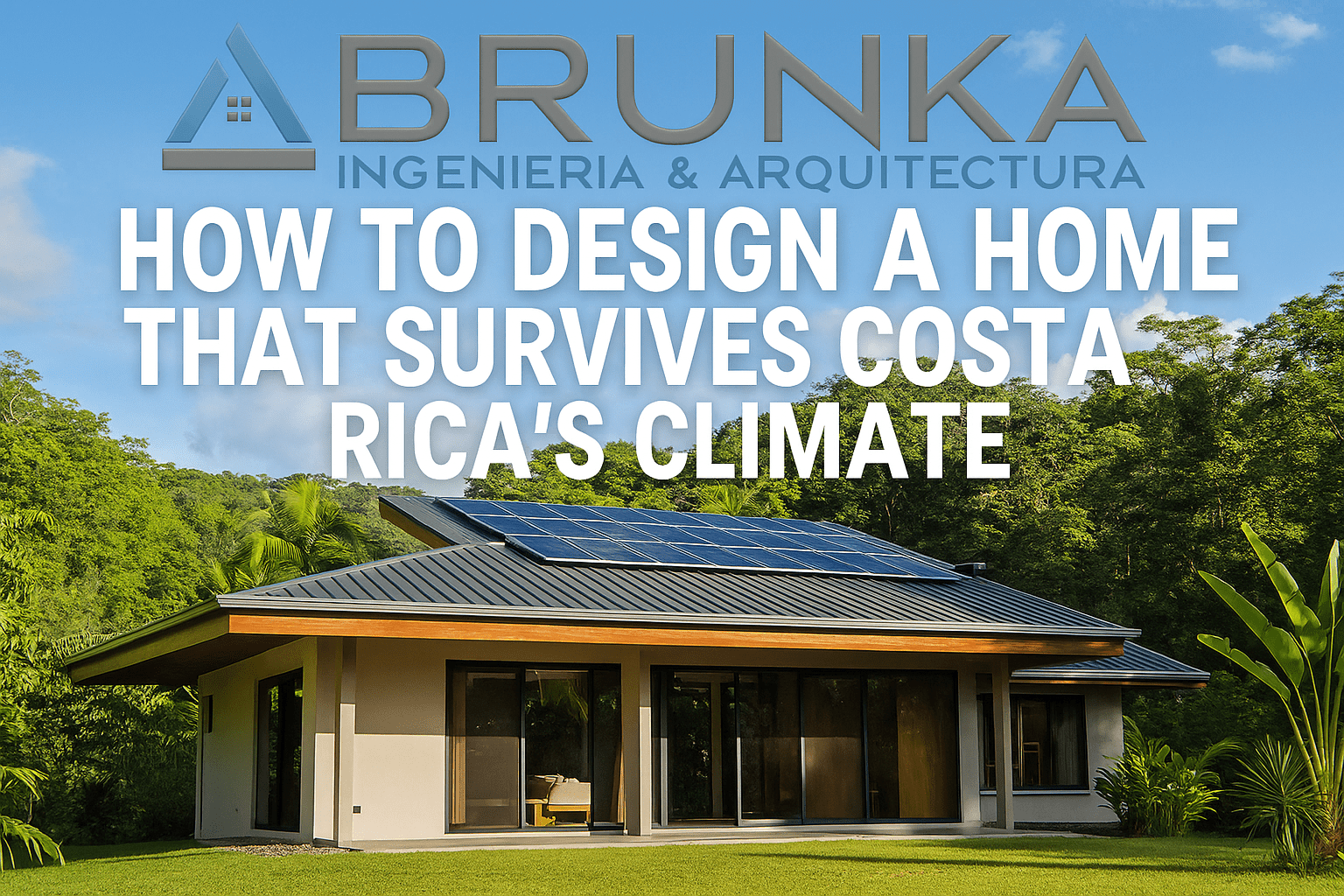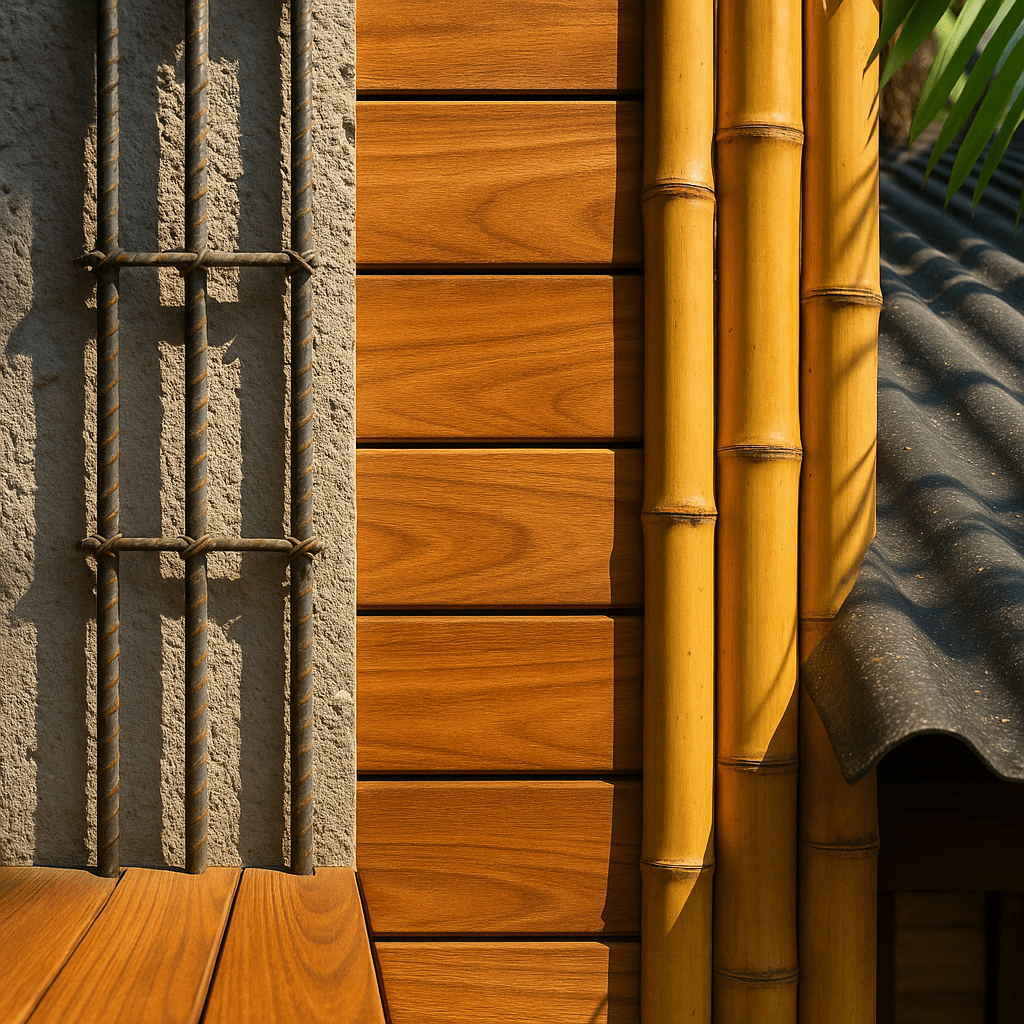
How to Design a Home That Survives Costa Rica’s Climate
Summary
- Costa Rica’s tropical climate demands resilient, eco-friendly home design.
- Heavy rains, humidity, and earthquakes require smart material choices.
- Natural ventilation and shading reduce energy use by up to 40%.
- Certifications like LEED and EDGE boost property value and sustainability.
- Here’s a practical guide to building a home that thrives in Costa Rica.
Understanding Costa Rica’s Climate Challenges
Living in Costa Rica is a dream for many — lush jungles, ocean views, and year-round tropical warmth. But the same environment that makes this country beautiful also creates unique challenges for homeowners.
- Heavy Rainfall: The rainy season (May to November) can bring daily downpours that test a home’s drainage and roofing systems.
- High Humidity: Coastal and jungle areas suffer from extreme moisture that damages wood, encourages mold, and shortens material lifespans.
- Seismic Activity: Costa Rica sits on the Pacific Ring of Fire, so earthquake-resilient design is non-negotiable.
- Salty Air: In beachfront zones like Jacó and Tamarindo, salt corrodes metal quickly.
Designing a home here means adapting to the environment, not fighting against it.
1. Site Orientation and Natural Ventilation
The first rule of Costa Rican home design is work with the climate, not against it.
Orient your home to capture natural breezes. For example, in Guanacaste, I’ve seen villa projects achieve up to 30% cooler indoor temperatures simply by aligning windows east-to-west. Cross-ventilation reduces dependence on air conditioning, saving thousands of dollars annually.
Shading is equally important. Wide overhangs, pergolas, and native trees can block direct sun while allowing airflow. This strategy not only makes a house more comfortable but also lowers long-term maintenance caused by UV exposure.
Check out our Costa Rica home design services for expert orientation strategies.
2. Choosing Climate-Resilient Materials
Your material choice can determine whether a home lasts 50 years or just 15 years in Costa Rica’s demanding climate. Constant rain, salty coastal air, and seismic activity all test a building’s durability, so investing in resilient, locally appropriate materials is essential
Best options include:
- Concrete & Steel Reinforcement: The backbone of seismic safety, providing the structural flexibility needed in earthquake-prone regions.
- Treated Teak & Bamboo: Naturally resistant to pests, humidity, and decay, they perform far better than untreated woods.
- Recycled Plastic Roofing: Withstands both torrential rains and corrosive ocean breezes.
Cross-Laminated Timber (CLT): A sustainable material that offers both earthquake resilience and a warm, natural look.

In a beachfront property in Jacó, replacing untreated wood with certified teak extended the deck’s lifespan by 3x while requiring less maintenance. That’s the difference local knowledge makes.
Learn more about sustainable materials in architecture.
3. Roof Design: Your First Line of Defense
In Costa Rica, the roof is not just a design element — it’s the first line of defense against the tropical climate. With rainfall that can exceed 100 inches a year in some regions and the relentless coastal sun, the wrong roofing choice can lead to leaks, structural damage, and constant repairs.
- Pitch and Overhangs: Steeply pitched roofs (20°–30°) shed heavy rain quickly, preventing leaks. Overhangs protect walls and windows from daily downpours while shading interiors from intense heat.
- Gutters and Drainage: Poor drainage is the #1 reason for structural problems during the rainy season. Oversized gutters and ground-level French drains are must-haves.
- Materials: Metal roofs with anti-corrosive coatings are excellent for coastal homes, while recycled plastic tiles offer a sustainable option that resists both rain and salt.
Case study: A Monteverde eco-lodge reduced roof repair costs by 60% after switching to recycled plastic tiles, proving sustainable doesn’t mean sacrificing performance.
4. Humidity and Mold Control
Humidity is one of the toughest challenges for homes in Costa Rica, especially in coastal towns like Tamarindo or jungle regions such as Puerto Viejo. Constant moisture creates the perfect breeding ground for mold, which can damage interiors, shorten material lifespans, and even affect health. Smart design is the best line of defense.
- Elevated Foundations: Raising the home a meter off the ground reduces ground moisture intrusion.
- Ventilated Crawl Spaces: Allow air circulation under the house.
- Dehumidifying Systems: Energy-efficient units combined with natural airflow cut mold risk significantly.
- Moisture-Resistant Finishes: Use lime plaster or breathable paints instead of synthetic coatings that trap water.
In Tamarindo, one client’s villa cut annual mold remediation costs from $4,000 to under $600 after redesigning airflow and materials.
5. Earthquake-Resilient Design
Costa Rica’s location along the Pacific Ring of Fire makes seismic resilience a non-negotiable element of home design. The country’s building codes classify it as Seismic Zone IV, which means structures must withstand frequent tremors and occasional major quakes. Ignoring this reality can turn a dream home into a liability.
Key features include:
- Flexible Structural Systems: Reinforced concrete frames absorb shock.
- Lightweight Materials: CLT walls and bamboo framing reduce collapse risk.
- Foundation Anchoring: Deep pilings and tie-beam systems keep structures stable.
In practice, earthquake-ready homes not only protect lives but also preserve property value. Buyers are quick to avoid structures with seismic vulnerabilities. By integrating these strategies from the start, you ensure that your home in Costa Rica is not just beautiful, but safe and enduring.
6. Energy Efficiency for Tropical Living
Building an energy-efficient home in Costa Rica isn’t just about saving on utility bills — it’s about designing for comfort in a tropical climate. The key is to minimize reliance on air conditioning while maintaining a naturally cool home. Cross-ventilation layouts, shaded overhangs, and reflective roofing materials reduce indoor heat buildup, while insulated walls help stabilize temperature swings between hot days and cooler nights.
Strategies that work in Costa Rica:
- Solar Panels + Battery Storage: Many Guanacaste villas now cover 70–90% of their energy needs.
- Low-E Glass Windows: Reflect heat without blocking views.
- Rainwater Harvesting: Provides irrigation and reduces strain on municipal systems.
- Smart Home Integration: Automated fans, shutters, and lights adapt to daily climate changes.
By integrating solar and natural cooling, one EDGE-certified home in Nosara cut utility bills by 42%, saving around $1,800 per year.
7. Local Certifications and Value Boost
In Costa Rica, sustainable certifications aren’t just green badges — they’re market advantages.
- LEED Certification: Recognized globally for energy and water efficiency.
- EDGE Certification: Designed for tropical regions, reducing energy/water use by 20%+.
- CSC (Certificación de Sostenibilidad en la Construcción): A local program that evaluates environmental impact in Costa Rican projects.
Homes with these certifications command 15–25% higher resale value and attract international buyers seeking sustainable investments.
Learn more from IFC EDGE Buildings.
Conclusion
Designing a home in Costa Rica is about more than style — it’s about building resilience into beauty. From smart orientation in San José to humidity-proofing in Tamarindo and seismic safety in Monteverde, the right strategies turn challenges into advantages.
A well-designed home here doesn’t just survive the climate — it thrives, offering comfort, safety, and long-term value.
If you’re planning a project in Costa Rica, partnering with local experts makes all the difference. Explore how we can help at Architect Engineer. Let’s design a home that endures Costa Rica’s climate while embracing its natural beauty.
FAQs
Q1: What is the best roofing material for Costa Rica’s climate?
Metal roofs with anti-corrosive coatings or recycled plastic tiles are most durable against heavy rain and salty coastal air.
Q2: How do I protect my home from humidity in Costa Rica?
Elevated foundations, cross-ventilation, and moisture-resistant finishes significantly reduce mold and humidity issues.
Q3: Are Costa Rica’s building codes earthquake-ready?
Yes, but enforcement varies. Work with certified architects and engineers familiar with Seismic Zone IV standards.
Q4: Do green certifications increase property value in Costa Rica?
Absolutely. Homes with LEED, EDGE, or CSC certifications often sell faster and at a premium of 15–25%.
Q5: Can foreign investors build sustainable homes in Costa Rica?
Yes. Many international buyers work with local architects to design climate-smart villas and eco-lodges.



